Delivering client projects on time while balancing service desk operations is one of the biggest challenges MSPs face. Between onboarding, cloud migrations, security rollouts, and internal infrastructure updates, project workloads often compete directly with ticket queues—leading to bottlenecks, SLA pressure, and inconsistent delivery.
MSP project management software provides structure, visibility, and workflow efficiency. Unlike generic project tools, these systems integrate directly with PSA platforms, aligning tasks, resources, time entries, billing, and approvals in one place.
Below, we break down what MSP project management software is, why it matters, and how automation enhances project delivery for modern MSPs.
What Is MSP Project Management Software?
MSP project management software helps managed service providers plan, track, and deliver client and internal projects using structured workflows that integrate with PSA systems. It aligns tasks, resources, SLAs, and billing into a unified framework—something traditional project tools like Trello, Asana, or Wrike cannot do on their own.
It is designed specifically for MSP operational environments where ticket queues, client SLAs, and project timelines need to work together.
Why MSPs Need Project Management Capabilities
MSPs rely on project workflows to deliver complex, high-value outcomes for clients. Typical use cases include:
Client onboarding
Setting up infrastructure, accounts, documentation, devices, and security controls.
Cloud migrations
Managing change windows, technical risks, and multi-stage deployment processes.
Security & compliance projects
Rolling out MFA, cyber essentials, audits, and policy updates.
Internal IT upgrades
Hardware refreshes, datacentre changes, tool-stack transitions, or network redesigns.
Good project management is directly tied to profitability, SLA performance, and resource availability across the service desk.
Core Principles of MSP Project Management Software
Most effective MSP project management platforms include:
1. Visibility
A centralised view of tasks, timelines, dependencies, and technician workload.
2. Integration
Connections to PSA, service desk, RMM, and documentation systems.
3. Automation
Automatically creating tasks, escalating delays, generating updates, or syncing progress.
4. Governance
Standardised project templates, approval workflows, and client communication rules.
Key Features to Look For
Strong MSP project management tools typically offer:
- Task assignment and resource allocation
- Milestone and dependency tracking
- SLA-aligned scheduling
- Client communication and approval gates
- Reporting tied to PSA time entries and billing
These features ensure both internal efficiency and clear client accountability.
PSA vs. Standalone Project Management Tools
MSPs generally choose between two approaches:
PSA-Based Project Management
Examples: Autotask, ConnectWise Manage, HaloPSA.
- Integrated billing and time entry
- Strong alignment with service desk workflows
- Ideal for client-facing projects
Standalone PM Tools
Examples: ClickUp, Wrike, Asana.
- More flexible workspaces
- Better collaboration features
- Useful for internal or non-billable projects
Most MSPs use PSA project modules for client work—and standalone tools for internal initiatives.
How Automation Enhances MSP Project Delivery
Automation and AI now play a major role in modern project management. Examples include:
Auto-generating project tasks
From onboarding forms, tickets, or specific triggers.
Tracking SLA risks
Surfacing timeline breaches and delays automatically.
Automated client status updates
Sending milestone summaries or weekly digests without manual effort.
Forecasting resource conflicts
Identifying overloaded teams or project collisions.
Automation shifts project management from reactive schedule chasing to proactive workflow execution.
Implementation Checklist
A simple step-by-step process for MSPs getting started:
1. Choose your PSA or PM tool
Ensure it supports workflows for both client and internal projects.
2. Build project templates
Onboarding, migrations, compliance, deployments, infrastructure changes.
3. Connect ticketing & PSA workflows
Ensure tasks flow naturally between service desk and project teams.
4. Automate approvals & reporting
Use triggers for client notifications, internal updates, and milestone sign-offs.
5. Train teams and iterate
Success depends on consistent use and refinement over time.
Common Pitfalls & How to Avoid Them
Over-customising templates
Complex workflows slow delivery and confuse technicians.
Limited client visibility
Clients should be able to track progress without constant updates.
Weak PSA integration
Leads to inaccurate billing and misaligned workloads.
Ignoring SLA impact
Projects must be coordinated with service desk capacity.
How Neo Agent Fits Into Project Management
Neo Agent is not a project management system—but it enhances MSP project delivery by automating repetitive workflows around it.
Neo works alongside PSA and PM tools by:
- Automatically generating tasks from ticket workflows
- Updating PSA records and documentation
- Routing approvals to managers or clients
- Automating communication and project updates
By handling these repetitive steps, Neo Agent reduces admin overhead and ensures smooth execution across teams.

